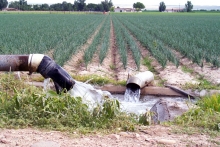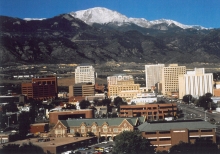- Home
- Admin
- Meetings
- Fry-Ark Project
- Projects
- Water Management
- Agriculture Conservation
- Arkansas River Basin Water Rights
- Conservation Plans
- Conservation & Education
- Education
- Fryingpan-Arkansas Project Water Import Tracking
- Inclusion into the Southeastern Colorado Water Conservancy District
- Legislation
- The Allocation of Fryingpan-Arkansas Project Water & Project Water Return Flows
- RRA
- Snow Pack Monitoring
- Water Conservation BMP Tool Box
- Winter Water Storage
- Water Wise Gardening
- Login
Benefits

Today we enjoy the benefits of the Fryingpan-Arkansas Project. The Project provides water for growing communities, businesses, industry, and agriculture. Project water helps to sustain fish and wildlife and is used for rafting, fishing, and boating. The Project has protected us from devastating floods and produces clean energy to meet our needs.
 Water diverted from the western slope and regulation of Arkansas River flows provides supplemental irrigation water for 265,000 irrigable acres in the Arkansas Valley. The Fryingpan-Arkansas Project enables farms to sustain and possibly increase the level of present agricultural productivity per acre. It permits farmers to diversify crops produced and to be more responsible to market demands for food and fiber. Because of the ability to diversify crops and meet peak irrigation demands, the value of total crop production in the Arkansas Valley has increased. Major crops grown include alfalfa, corn, and sorghum. Specialty crops such as onions, beans, tomatoes, melons, and seed crops are also grown in the valley.
Water diverted from the western slope and regulation of Arkansas River flows provides supplemental irrigation water for 265,000 irrigable acres in the Arkansas Valley. The Fryingpan-Arkansas Project enables farms to sustain and possibly increase the level of present agricultural productivity per acre. It permits farmers to diversify crops produced and to be more responsible to market demands for food and fiber. Because of the ability to diversify crops and meet peak irrigation demands, the value of total crop production in the Arkansas Valley has increased. Major crops grown include alfalfa, corn, and sorghum. Specialty crops such as onions, beans, tomatoes, melons, and seed crops are also grown in the valley. 

FISH and WILDLIFE: The importance of maintaining, and where possible improving fish and wildlife habitat, was a major concern of those who designed the Fryingpan-Arkansas Project.
Dominant game fish found in Project area rivers, streams, and reservoirs on the western slope include rainbow, brown, cutthroat, and brook trout. Development of Ruedi Dam and Reservoir has increased the available reservoir fish habitat in the area. Operating criteria of the dam on the Fryingpan River has exposed about six acres of gravel area immediately below the dam which provide spawning beds for brown trout. The gravel area and regulated streamflow have improved the fishery below Ruedi Dam through increased natural reproduction and have increased recreation opportunities in the immediate area. The Fryingpan River below Ruedi Reservoir sports a gold-medal fishery.
Development of Turquoise Lake has increased the aquatic habitat and surface acreage available for fish. Species in this area include kokanee salmon, rainbow, brown, and lake trout. Both Twin Lakes and Turquoise Reservoirs are popular for ice-fishing. The increased fishing activity requires stocking about 16 tons of hatchery-reared fish each year.
The most common big game species within both the western and eastern slope areas are deer and elk. Big and small game hunting are allowed in these areas . To ensure big game migration, patterns were not permanently interrupted and all conduits in the collection system were buried.
FISH HATCHERIES: The Mt. Elbert conduit delivers up to 3,000 gallons per minute of high quality water to the Leadville National Fish Hatchery. Increased fish production at the hatchery, is made possible by the increased quality and improved temperature of the water supply. To enhance recreation and fishing, the Bureau of Reclamation built a $22 million, state–of-the-art cold and warm-water fish hatchery just below Pueblo Dam. It is managed by the Colorado Parks and Wildlife and provides significant capability for the State to produce a variety of fish species to stock in its lakes and rivers.

Regulation of erratic and often destructive flood flows is a benefit of the Fryingpan-Arkansas Project. Seventy-eight persons died and damages exceeded $19 million when floodwater ravaged Pueblo in 1921. In 1965, flooding in the Fountain Creek area east of the City of Pueblo produced extensive damage. Flooding was reported as far as 90 miles downstream.
Fear of flooding has been reduced considerably with the construction of Pueblo Dam and Reservoir. The Reservoir has a reserved minimum capacity of 27,000 acre-feet for flood water storage.

Like a monument to its namesake, the Mt. Elbert Pumped-Storage Powerplant stands at the foot of Colorado’s highest peak, the 14,422 foot Mt. Elbert. The building was designed along modern architectural lines. The all-concrete structure is equivalent to a 14-story building, though most of the structure is below ground.
The energy for power generation comes from water stored in the Mt. Elbert Forebay. This stored water drops an average of 445 feet through two pipes called penstocks to the Powerplant below. Force of the falling water spins two hydroelectric generators developing a total of 233 megawatts per hour of electrical power annually. This is enough power to serve the annual electrical needs of 26,200 homes. The generators are also designed to operate as a 170,000 horsepower electric motor which drives the turbines in reverse to pump the same water back up to the forebay so it can be used again to generate more power.
This pump-back storage principal is advantageous because the generating units can be started quickly, and adjustments of power output can be made rapidly to respond to varying patterns of daily and seasonal power demands.
 Water for municipal and industrial use was developed by the Fryingpan-Arkansas Project to supplement existing supplies. Two separate water delivery pipeline systems, the Fountain Valley Conduit and the proposed Arkansas Valley Conduit, will serve communities on the eastern slope. The Fountain Valley Conduit extends north to deliver water to the Colorado Springs area. When it is built, the Arkansas Valley Conduit will transport clean water to users in the Arkansas Valley as far east as Lamar, Colorado.
Water for municipal and industrial use was developed by the Fryingpan-Arkansas Project to supplement existing supplies. Two separate water delivery pipeline systems, the Fountain Valley Conduit and the proposed Arkansas Valley Conduit, will serve communities on the eastern slope. The Fountain Valley Conduit extends north to deliver water to the Colorado Springs area. When it is built, the Arkansas Valley Conduit will transport clean water to users in the Arkansas Valley as far east as Lamar, Colorado.
Recreation facilities were developed throughout the Fryingpan-Arkansas Project by the Bureau of Reclamation in cooperation with the National Park Service, U.S. Forest Service, and
 State and local agencies. Extensive recreational use has been recorded at all Project reservoirs since their construction or enlargement.
State and local agencies. Extensive recreational use has been recorded at all Project reservoirs since their construction or enlargement.
Ruedi Reservoir on the western slope where snowcapped peaks over 14,000 feet high and thickly forested slopes provide an exceptionally beautiful setting for boating, water skiing, fishing, picnicking, and camping.
Recreation on the eastern slope at Turquoise Lake includes sightseeing, fishing, camping, picnicking, swimming, water skiing, boating, and hunting. Existing recreation development in the area of Twin Lakes is also water-oriented with fishing and boating being the major activities.

Recreational development at Pueblo Reservoir has helped fulfill the need for water-oriented recreation in the Arkansas valley. Recreational facilities were built by the Bureau of Reclamation and are managed by Colorado Parks and Wildlife. There are two marinas, five campgrounds with 400 campsites, four group picnic sites, five picnic areas, north and south shore boat ramps, and numerous fishing access areas along the reservoir. Downstream of Pueblo Dam there is a day-use development which contains a swimming pond with sandy beach, bath house complex, fishing pond, and picnic sites.
Construction and use of Fryingpan-Arkansas Project facilities stimulates the local economic activity and continues to generate benefits to the local economy. This economic stimulus complements winter skiing activity, providing a year-round recreational economy in the area.
Arkansas River White-Water Rafting

The Arkansas River is one of the most popular rafting rivers in America and this 165 miles section of river is internationally recognized for its whitewater experience. From its headwaters at the historic mining area around Leadville, Colorado; through scenic mountain towns like Buena Vista and Salida, Colorado; to the breathtaking Royal Gorge and beyond Colorado's Arkansas River have some of the nation's most exciting whitewater and amazing mountain views. Rafting channels range from highly technical Class IV and V rapids to relaxing & scenic calm-water float trips. The Fryingpan-Arkansas Project has supported white-water recreational rafting for many years, through the Upper Arkansas Voluntary Flow Management Program.
 The Fryingpan-Arkansas Project has awarded the constituents of the Southeastern Colorado Water Conservancy District 50 years of golden benefits (1965-2012). Looking forward to the next 50 years, the Fryingpan-Arkansas Project will continue to supply southeastern Colorado with these valuable benefits and more.
The Fryingpan-Arkansas Project has awarded the constituents of the Southeastern Colorado Water Conservancy District 50 years of golden benefits (1965-2012). Looking forward to the next 50 years, the Fryingpan-Arkansas Project will continue to supply southeastern Colorado with these valuable benefits and more.
The District and the Bureau of Reclamation are planning the development and construction of the Arkansas Valley Conduit (Conduit). The Conduit is an original component of the Fryingpan-Arkansas Project but has not been built. When completed, the Conduit will deliver clean drinking water to approximately 50,000 people in southeastern Colorado.
The District is also pursuing legislation to enlarge both Sugar Loaf Dam on Turquoise Lake and Pueblo Dam. Enlarging these facilities will provide additional water storage space needed by the region.
A bright future filled with many more benefits lies ahead for the next 50 years for the Fryingpan-Arkansas Project and southeastern Colorado.
Copyright © 2025 Southeastern Colorado Water Conservancy District
